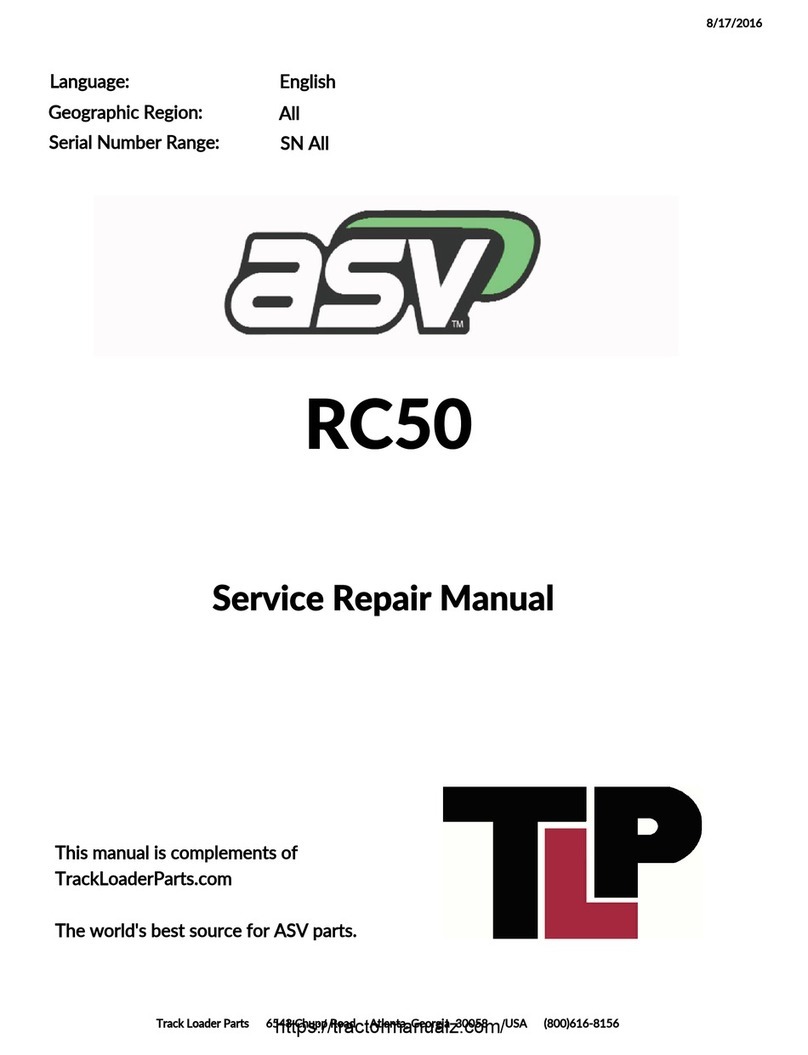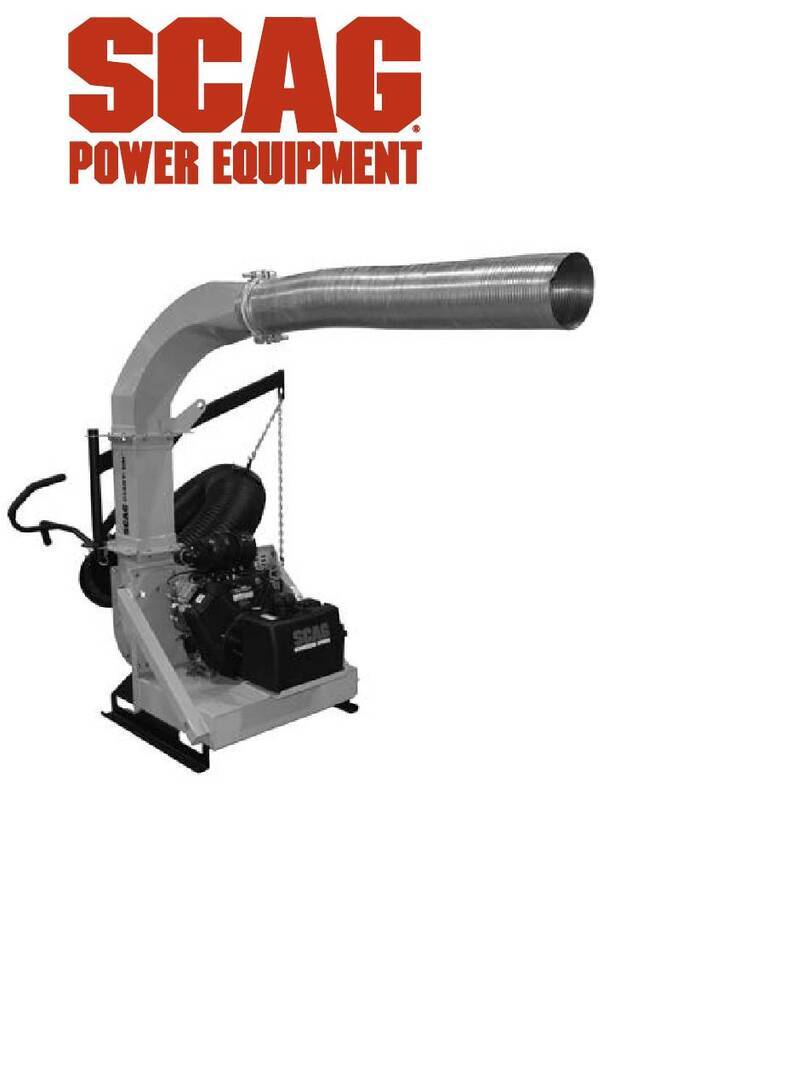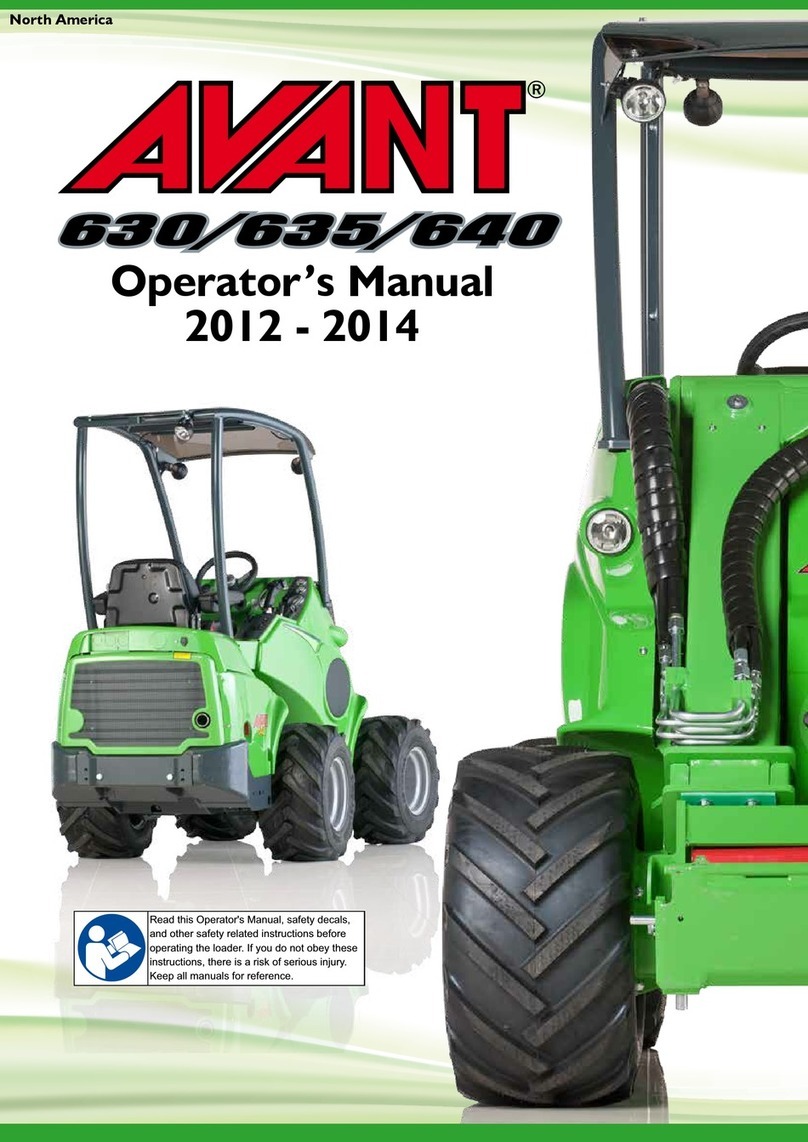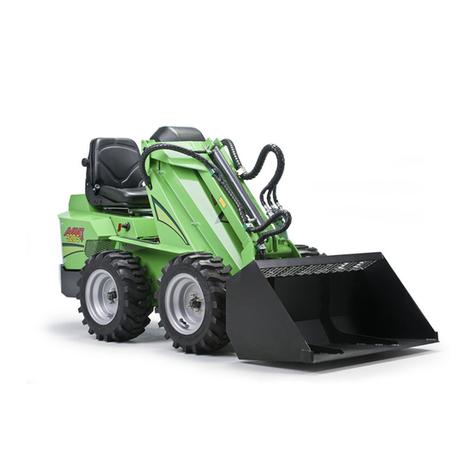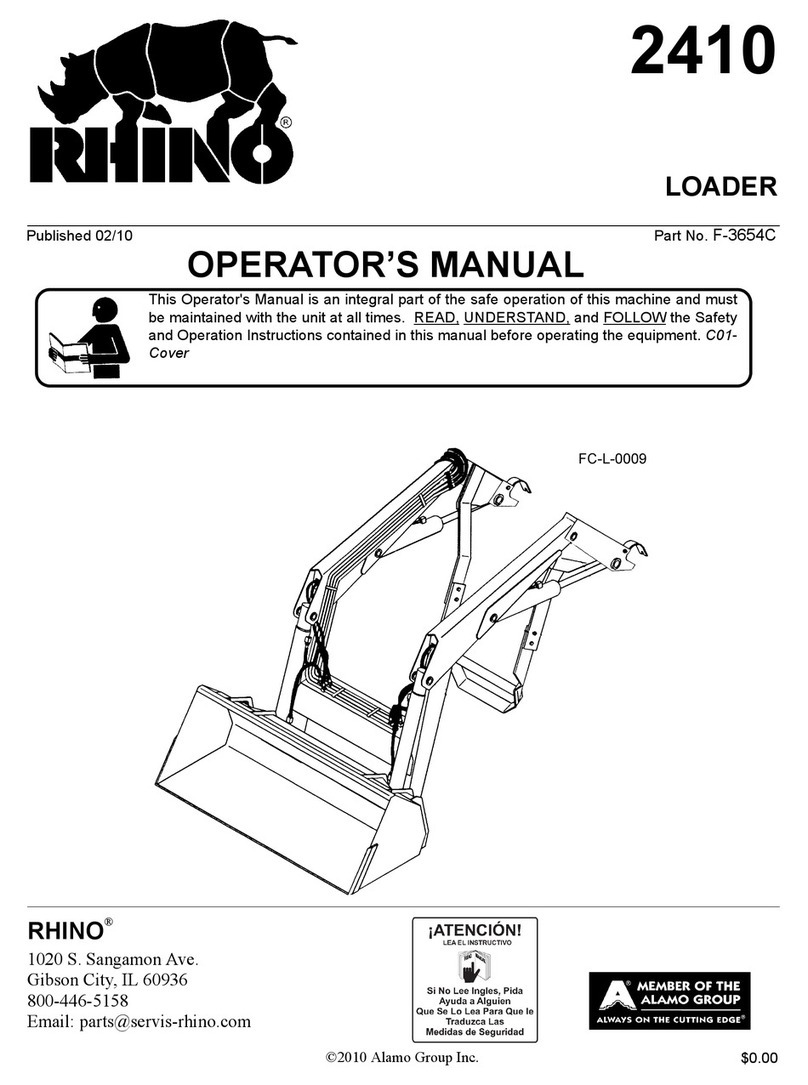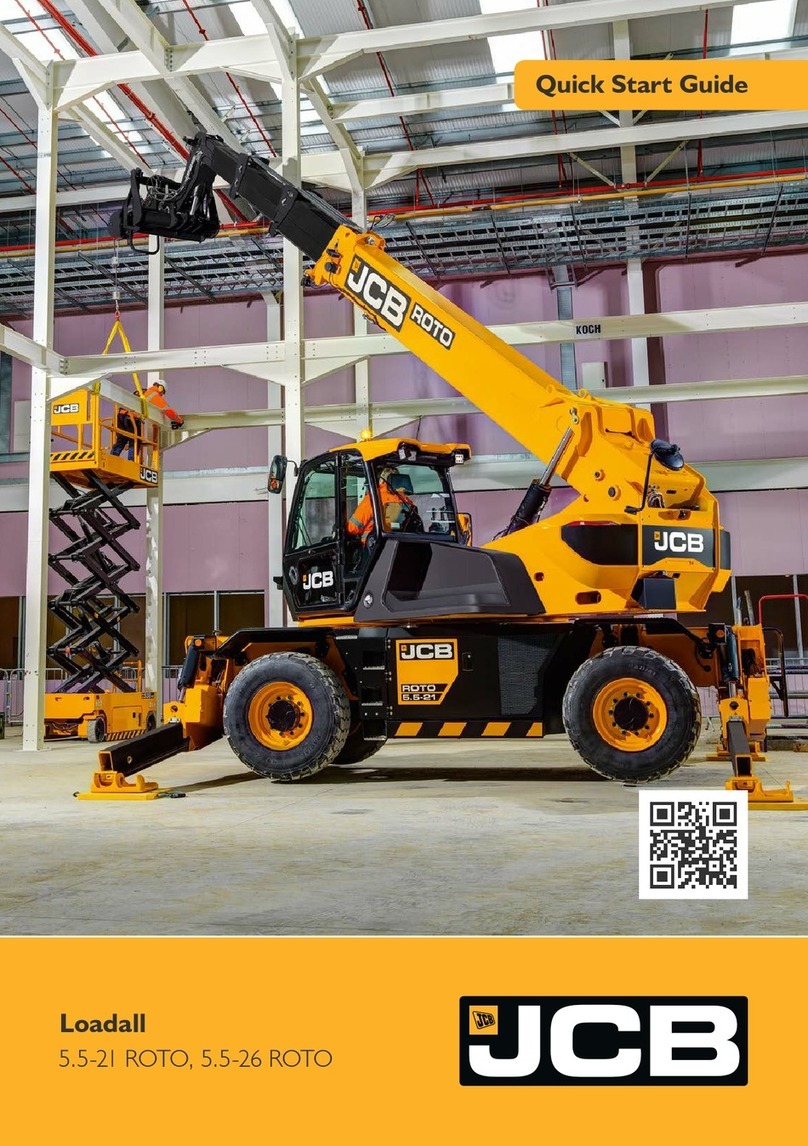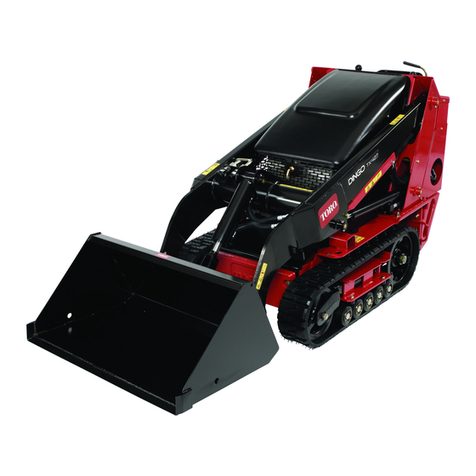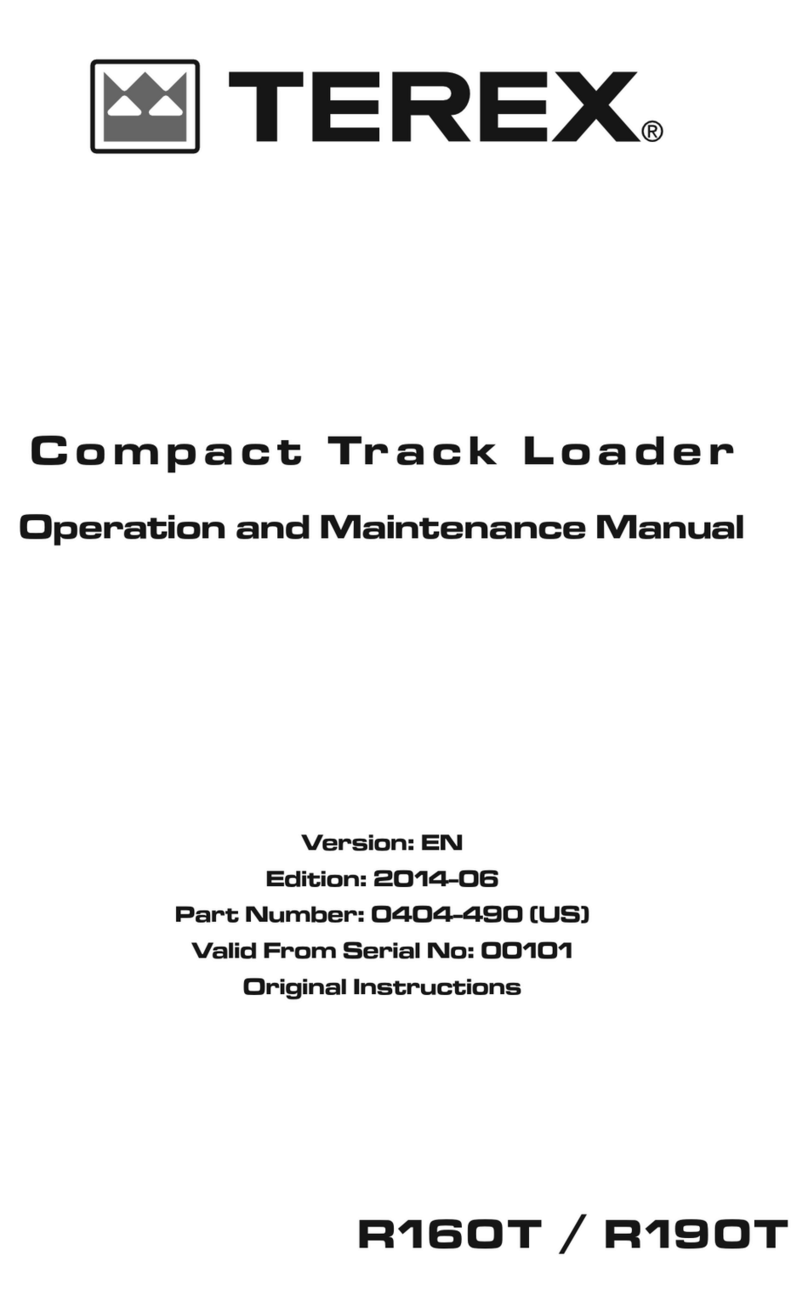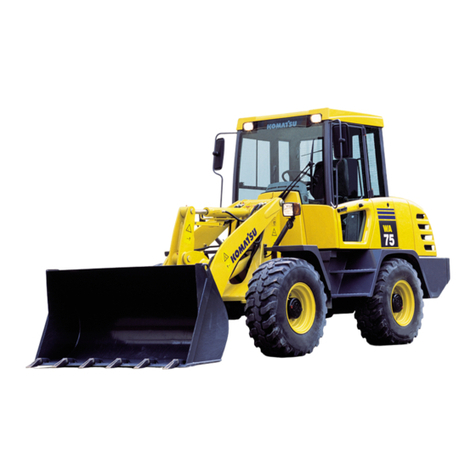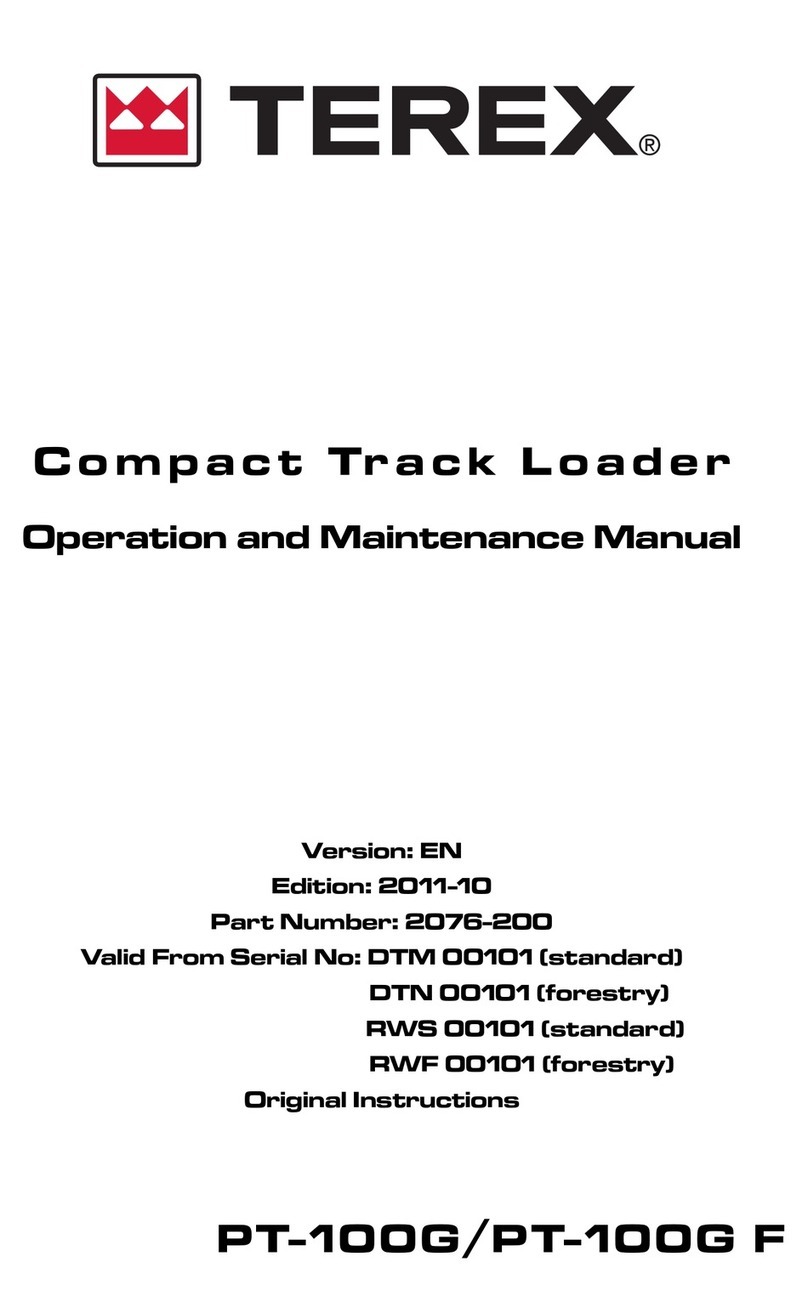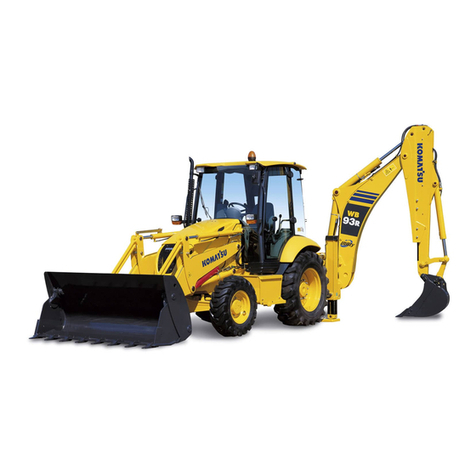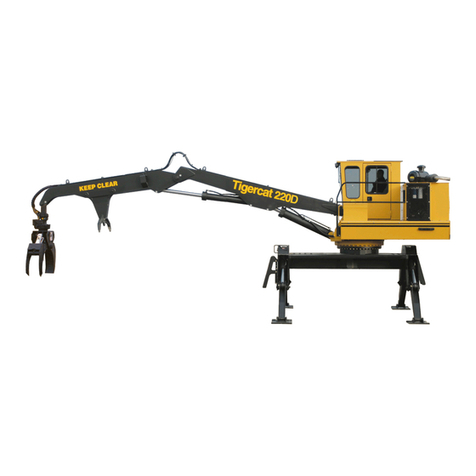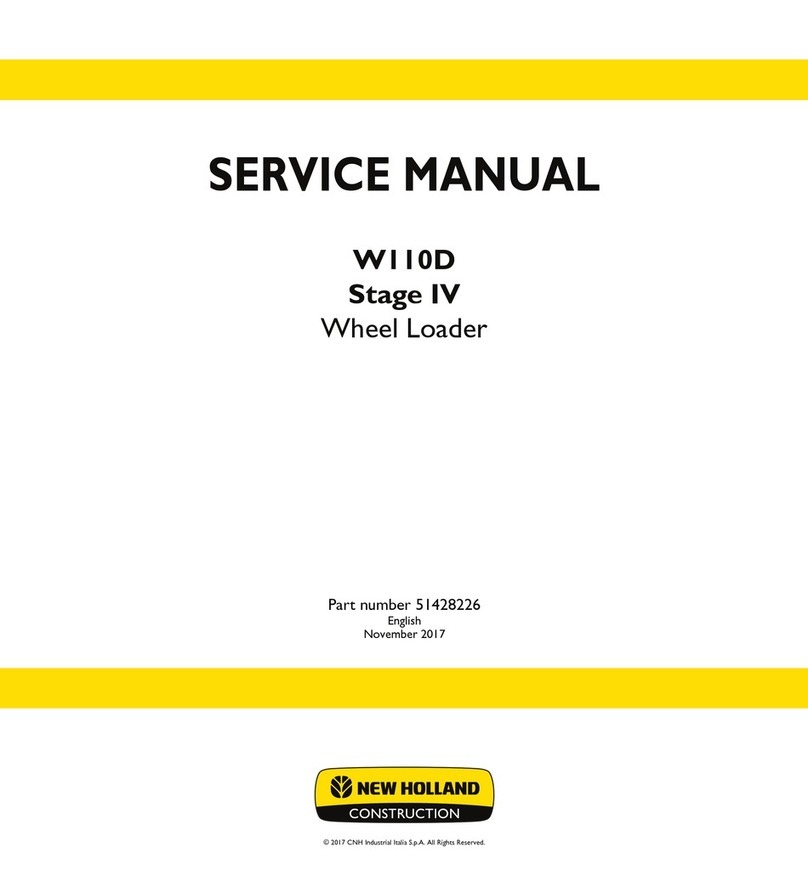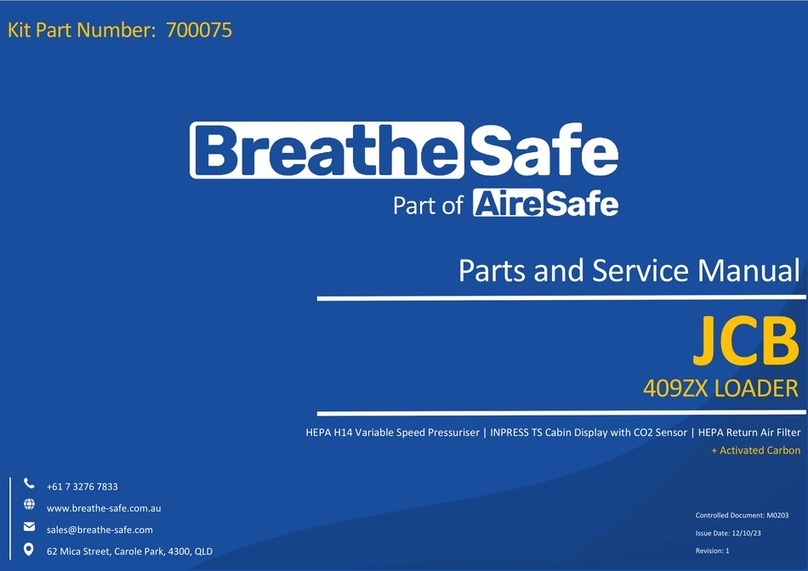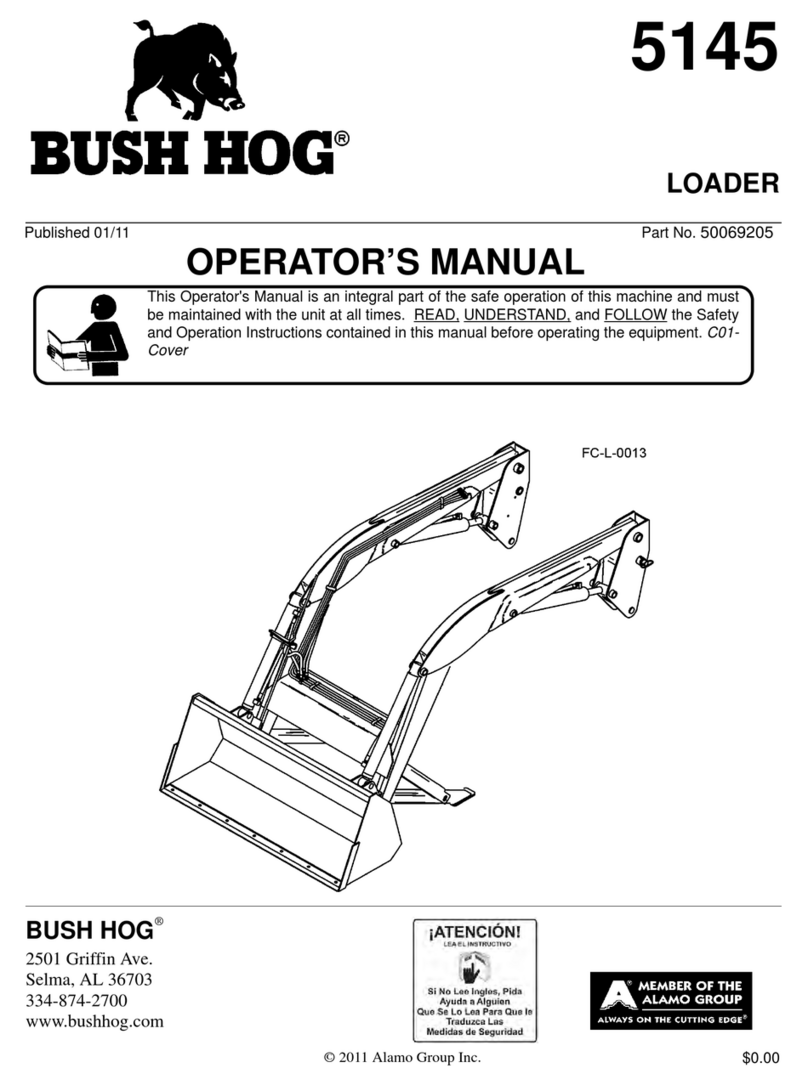Giant-Vac 35hp Series User manual

ASSEMBLYINSTRUCTIONS
SAFETYRULES
PARTSLIST
35hpseries
TruckLoader
Actual product differs from product pictured above
Model No. Description
3800023 TLB35252BVG
Manual No. 3100011
Revision: - 01
/
01/09

1
preliminaries
Congratulations!
You have just purchased one of the finest pieces of outdoor power equipment on the market today. If properly
cared for, your new truck loader will provide years of dependable service. Please read and follow this
instruction manual carefully in order to get the most out of your new equipment.
As you carefully uncrate your unit, you will find the following items:
1 Power Unit
1 Discharge Stack &Elbow Assembly
1 12” x 6’ Metal Discharge Hose (standard units)
1 16” x 7’ Intake Hose (standard units)
1 Horizontal Hose Support Boom Member
1 Parts Accessory Kit including:
1 – 16” Intake Nozzle
4 – 16” Hose Clamps
1 – Hose Support Boom Horizontal Member
1 – 12” Squeeze Ring
1 – Package of assembly hardware
1 – Package containing operating manuals and warranty registration
Each product leaves our factory in excellent condition; occasionally, however, some damage may occur during
shipment. If any such damage is found upon initial inspection, immediately notify the transport carrier who
delivered your machine, as they are solely responsible for such damage, as well as any subsequent
adjustments necessary.
Before assembly, please take a moment and record your model number and serial number below for
future reference (both numbers are located on the silver tag adhered to the engine side of the impeller
housing assembly):
Model number_______________________________
Serial number________________________________
Also be sure to promptly fill out and return the warranty registration enclosed in your manual packet.
Your new loader requires very little assembly. Simply follow the instructions contained within this manual to
begin enjoying the benefits of your new unit.
CALIFORNIA PROPOSITION 65 WARNING
Gasoline and Diesel engine exhaust and some of its constituents are known to the State of California to cause cancer, birth defects and
other reproductive harm.
As an owner of off-road gasoline or diesel engine equipment and/or as an employer, you also may have an obligation under the
California Occupational Safety and Health Act or under Proposition 65 to warn persons exposed to gas and diesel engine exhaust
and/or other Proposition 65 chemicals in and around your workplace. See California Health and Safety Code section 25249.5, Title 22 of
the California Code of Regulations at Section 1200 er seq., and Title 8 of the California Code of Regulations Section 5194. R0603.1

2
safetyrulesregardingoutdoorpowerequipment
PLEASE READ THE FOLLOWING BEFORE ASSEMBLING OR OPERATING UNIT
TRAINING
• Read, understand, and follow all instructions in the
manual and on the unit before starting. If the
operator(s) or mechanic(s) can not read English it is
the owner’s responsibility to explain this material to
them.
• Become familiar with the safe operation of the
equipment, operator controls, and safety signs.
• All operators and mechanics should be trained.
The owner is responsible for training the users.
• Only allow responsible adults, who are familiar
with the instructions, to operate the unit.
• Never let children or untrained people operate or
service the equipment. Local regulations may
restrict the age of the operator.
• The owner/user can prevent and is responsible for
accidents or injuries occurring to themselves, other
people or property.
PREPARATION
• Evaluate the terrain to determine what
accessories and attachments are needed to
properly and safely perform the job. Use only
accessories and attachments approved by the
manufacturer.
• Wear appropriate clothing including safety shoes,
safety glasses and ear protection. Long hair, loose
clothing or jewelry may get tangled in moving parts.
• Inspect the area where the equipment is to be
used and remove rocks or any other such objects
which can damage the machine or the receiver box.
• Use extra care when handling gasoline and other
fuels. They are flammable and vapors are
explosive.
a) Use only an approved container.
b) Never remove fuel cap or add fuel with the
engine running. Allow engine to cool before
refueling. Do not smoke.
c) Never refuel or drain the machine indoors.
• Check that operator’s presence controls, safety
switches and shields are attached and functioning
properly. Do not operate unless they are functioning
properly.
OPERATION
• Never run an engine in an enclosed area.
• Operate only in the daylight or with good artificial
light, keeping away from holes and hidden hazards.
• Be sure all components are securely in place and
in good operating order before starting engine.
• Be sure of your footing while using equipment,
especially when backing up. Walk, don’t run.
• Do not operate the unit without discharge
connected to a debris receiver box.
• Slow down and use caution when making turns
and when changing directions on slopes.
• Never leave a running unit unattended. Always
stop engine, and remove keys before leaving unit.
• Never operate without guards securely in place.
Be sure all safety features are attached, adjusted
properly and functioning properly.
• Never operate with intake or discharge
components loose, removed or altered.
• Do not change the engine governor setting or over
speed the engine.
• Stop on level ground, shut off engine before
leaving the operator’s position for any reason
including emptying the receiver box or unclogging
the intake or discharge.
• Stop equipment and inspect impeller blades after
picking up unusually large or hard objects or
abnormal vibration occurs. Make necessary repairs
before resuming operations.
• Keep hands and feet away from the intake and
discharge.
• Never carry passengers and keep pets and
bystanders away.
• Do not operate the unit while under the influence
of alcohol or drugs.
• Slow down and use caution when making turns
and crossing roads and sidewalks.
• Use care when hooking or unhooking the machine
to a towing vehicle.
• Use care when approaching blind corners, shrubs,
trees or other objects that may obscure vision.

2
safetyrulesregardingoutdoorpowerequipment(cont.)
SLOPE OPERATION
Slopes are a major factor related to loss-of-control
and tip-over accidents, which can result in severe
injury or death. All slopes require extra caution. If
you cannot back up the slope, or if you feel uneasy
on it, do not operate on it.
Do
• Remove obstacles such as rocks, tree limbs, etc.
• Watch for holes, ruts, or bumps. Uneven terrain
could overturn the unit. Tall grass can hide
obstacles.
• Use slow speed.
• Keep all movement on the slopes slow and
gradual. Do not make sudden changes in speed or
direction.
Do Not
• Do not start or stop on a slope. If tires lose
traction, stop the unit and proceed slowly straight
down the slope.
• Do not turn on slopes unless necessary, and then,
turn slowly and gradually downhill, if possible.
• Do not operate near drop-offs, ditches, or
embankments. The operator could lose footing or
balance or unit could suddenly turn over if a wheel
is over the edge of a cliff or ditch, or if an edge
caves in.
CHILDREN
Tragic accidents can occur if the operator is not
alert to the presence of children. Children are often
attracted to the unit and its activity. Never assume
that children will remain where you last saw them.
• Keep children out of the operating area and under
the watchful care of another responsible adult.
• Be alert and turn unit off if children enter the area.
• Before and during reverse operation, look behind
and down for small children.
• Never carry children. They may fall off and be
seriously injured or interfere with safe unit
operation.
• Never allow children to operate the unit.
• Use extra care when approaching blind corners,
shrubs, trees, or other objects that may obscure
vision.
EMISSIONS
• Engine exhaust from this product contains
chemicals known, in certain quantities, to cause
cancer, birth defects, or other reproductive harm.
• Look for the relevant Emissions Durability Period
and Air Index information on the engine emissions
label.
MAINTENANCE AND STORAGE
• Always observe safe refueling and fuel handling
practices when refueling the unit after
transportation or storage.
• Always follow the engine manual instructions for
storage preparations before storing the unit for both
short and long term periods.
• Always follow the engine manual instructions for
proper start-up procedures when returning the unit
to service.
• Never store the machine or fuel container inside
where there is an open flame, such as in a water
heater. Allow unit to cool before storing.
• Shut off fuel while storing or transporting. Do not
store fuel near flames or drain indoors.
• Keep all hardware, especially impeller bolt, tight
and keep all parts in good working condition.
Replace all worn or damaged decals.
• Never tamper with safety devices. Check their
proper operation regularly.
• Clean debris from units, drives, mufflers, and
engine to prevent fires. Clean up oil or fuel spillage.
• Stop and inspect the equipment if you strike an
object. Repair, if necessary, before restarting.
• Never make adjustments or repairs with the
engine running unless specified otherwise.
• Park machine on level ground. Never allow
untrained personnel to service machine.
• Use jack stands to support components when
required.
• Carefully release pressure from components with
stored energy. (e.g. springs)
• Check impeller on a regular basis for bent, worn
or cracked blades. Only replace impellers; never
straighten or weld them.
• Keep hands and feet away from moving parts.

2
safetyrulesregardingoutdoorpowerequipment(cont.)
• Belts and belt guard components are subject to
wear, damage, and deterioration, which could
expose moving parts or allow objects to be thrown.
Frequently check components and replace with
manufacturer’s recommended parts, when
necessary.
• Check operation of brake, tail and license lights
frequently. replace as required.
• Use only factory authorized replacement parts
when making repairs.
• Always comply with factory specifications on all
settings and adjustments.
• Only authorized service locations should be
utilized for major service and repair requirements.
• Never attempt to make major repairs on this unit
unless you have been properly trained. Improper
service procedures can result in hazardous
operation, equipment damage and voiding of
manufacturer’s warranty.
3
unitassembly&set-up
Note: Please refer to Parts List for correct part identification and placement. Parts list reference
numbers are called out by sheet number followed by reference number(s) on that sheet: (1:1) indicates
Sheet 1, reference number 1; (2:32,34-38) indicates Sheet 2, reference numbers 32 through 38 excluding
33; etc.
Important Safety Note: To prevent unit rollover during assembly and set up,
lock rear support leg in lowermost position possible. Failure to do this may
result in injury or death and/or damage to unit or property.
DISCHARGE ASSEMBLY
Safety Note: Assistance is required when installing discharge stack. If access to
lifting equipment is possible, it is highly recommended.
• Place stack & elbow assembly (3:1) atop power
unit, with discharge directed toward towing
hitch. Insert twelve 1/2-13 x 1-3/4” hex bolts
(3:2), each fitted with one flat washer (3:3),
through bolt flange holes, securing with flat
washers, lock washers and nuts (3:3-5).
Tighten securely.

3
unitassembly&set-up(cont.)
• Slip one end of metal discharge hose (3:6) onto
barrel of discharge stack.
• Secure hose in place with squeeze ring (3:7),
tightening all bolts securely enough to dimple
hose against barrel of stack and thereby
prevent slippage of hose on stack assembly.
INTAKE ASSEMBLY
• Slip two hose clamps (2:9) onto one end of
intake hose (2:8), then slip end of hose onto
intake flange barrel (2:5), located in front of
impeller housing. Tighten clamps securely.
• Slip Hose support band (2:10) about half-way
up the length of the hose, with eye clip facing
up.
• Slip two hose clamps onto free end of intake
hose, followed by Intake Nozzle (2:11) with
handle pointed upwards and toward hose.
Tighten clamps securely.
HOSE SUPPORT BOOM ASSEMBLY
• Attach yoke end of Threaded spring guide (5:5)
to second thru hole of horizontal boom member
(5:2) with one 1/2-13 x 3” hex bolt (5:3),
securing with 1/2-13 lock nut (5:4). Do not over
tighten lock nut. Note: Be sure spring guide
and chain eye at end of boom are both toward
bottom of boom member.
• Attach horizontal boom member to vertical
boom member (5:1) with one 1/2-13 x 3” hex
bolt, securing with 1/2-13 lock nut. Do not over
tighten lock nut. Be sure spring guide is toward
base of vertical boom member.
• Remove 3/4” hex nut and flat washer (5:6-7)
from bottom of threaded spring guide. Slip
thread down through hole in base of vertical
boom member, securing with same hardware
as previously removed.

3
unitassembly&set-up(cont.)
HOSE SUPPORT BOOM ASSEMBLY (cont.)
• Lift assembly and install into boom pivot
brackets on discharge stack, first slipping top
portion of vertical boom member into top
bracket on stack, then dropping bottom portion
into bottom bracket.
1
2
• Catch S-hook on one end of boom support
chain (5:9) into chain eye at end of horizontal
boom member.
• Slip other end of chain through eye clip atop
hose support band, then adjust chain length
between hose and boom to about three feet
(3/4 of total length) by slipping S-hook on end
of chain through appropriate mid-link.

3
unitassembly&set-up(cont.)
DEBRIS BOX CONSTRUCTION
WARNING: This unit is designed to be used in conjunction with a debris collection
box. NEVER run or operate your Truck Loader without a debris box.
Below are directions for constructing a simple, sturdy debris box for use in a standard pickup
bed:
• Cut four pieces of 3” angle iron to the inside length of the truck bed, four pieces to the inside width, then four
pieces that measure from the truck bed floor to approximately 8” higher than the top of the unit discharge
when the unit is connected to the truck. Either weld or securely bolt the box frame together.
• Line the inside front and sides with 3/4” exterior grade plywood.
• Cover the top of the frame with a heavy duty mesh screening to allow for adequate ventilation.
• Cut a plywood door the width and height of the box frame. Install a heavy duty hinge at the top of the door
and fasten it to the rear of the box frame. Install latches or other locking mechanisms between the lower
sides of the door and the box sides to keep the door from opening inadvertently.
• Mark the location on the door where the unit discharge meets the box, then cut a 16” diameter hole in the
door at that location. Install a rubber gasket around the hole to prevent debris blow-by – an old 13” or 14”
inner tube works fine.
CONNECTING UNIT TO TOWING VEHICLE
• Install appropriate trailer plug onto end of unit wiring harness to match socket on towing vehicle. Wiring
scheme is as follows:
Red – Right signal
Yellow – Left signal
Brown – Taillights
Green – Ground
• Raise or lower support jack until unit sits level with ground. Back towing vehicle up to draw bar, then
visually check draw bar for proper height alignment with hitch receiver on vehicle. Raise or lower draw bar
if needed by relocating in any of the remaining sets of height adjustment holes.
• With assistance behind, back up slowly, aligning both draw bar with hitch receiver and discharge hose with
receiver box opening.
• Lock pintle ring in hitch receiver, connect safety chains to vehicle in a criss-cross fashion to cradle draw bar
in case of accidental disconnect, then connect wiring harness plug into trailer socket of vehicle.
• Lift rear support leg and pin in uppermost position.
Note: To prevent possible rollover, lock rear support leg in lowermost position
possible when unit is parked or disconnected from towing vehicle.
Your unit is now ready to be started and checked for proper operation. See your engine
manual for proper engine prep and operation.

4
unitoperation
GENERAL GUIDELINES TO OBSERVE DURING OPERATION
• Never allow a person to ride, sit or stand on the unit. Never allow a person to ride, sit or stand
on the towing vehicle other than in the driver’s cab of the towing vehicle.
• Make sure that the driver of the towing vehicle has the operator of the unit in full view at all
times. Also, when operating the unit, instruct the operator to stay to the side of the machine,
never in front or behind.
• Collecting debris into piles for the machine to intercept prior to startup will save time and fuel
as well as wear and tear on the unit.
• We recommend the following for the most efficient performance: if debris is very dry, run the
machine at approximately half throttle; this will help reduce the amount of small particles of
debris escaping through the ventilation screen. If debris is wet or partially frozen, run the
machine at full throttle.
• Lower intake hose boom assembly until nozzle floats 2-3 inches from the ground, then adjust
engine throttle so that when nozzle is pushed to the ground, suction can be broken with
moderate effort using three fingers of one hand. This will make operation relatively easy and
comfortable.
• Time and experience will be your best guide in finding the most efficient performance from
your unit.
UNCOUPLING UNIT FROM TOWING VEHICLE
• Disconnect taillight/brakelight plug from towing vehicle receiver.
• Unhook safety chains from rear of towing vehicle.
• Crank down wheel jack until unit weight is lifted from towing vehicle.
• Drop rear support leg to lowermost position and secure with clevis and bridge pin. Note:
Failure to follow this step can result in unit rollover and serious personal injury and unit
damage.
• Open pintle receiver latch on towing vehicle, determine if pintle ring on unit will clear pintle
receiver on vehicle (crank down wheel jack an additional turn or two if not), and pull vehicle
away.

5
unitmaintenance
GENERAL MAINTENANCE
NOTE: Some maintenance services, such as engine repairs, electrical repairs, etc., should be
performed only by a qualified technician.
• Check overall condition of unit prior to each use, repairing or replacing worn, damaged or
missing components promptly. Check all fasteners regularly and tighten if necessary.
• Follow engine manufacturer’s recommendations for maintenance schedules. Use only
recommended parts, fluids and lubricants. Failure to follow manufacturer’s recommendations
may void manufacturer’s warranties.
• Lubricate impeller shaft bearings every 50 hours of operation. Use a high quality bearing
grease, available from your local dealer (or auto parts store).
• Maintain tire pressure as indicated on tire sidewall. Replace worn or damaged tires promptly.
• Keep engine free from a buildup of grass, leaves or excessive grease. An accumulation of
these combustible materials may result in a fire, or simply impede performance.
• Never change attachments or make any adjustments, repairs or replacements until the unit is
completely shut down and the battery is disconnected.

5
unitmaintenance(cont.)
STORAGE
• Keep the unit in locked storage to prevent unauthorized individuals, especially chidren, from
playing and/or tampering with the unit.
• When storing the unit for prolonged periods, it is recommended to disconnect the battery.
• Store fuel in an approved, clearly marked container.
• NO NOT store gasoline powered equipment or fuel containers in any closed area where heat-
radiating appliances or open pilot lights are present, unless the fuel has been completely
drained from the power equipment and the fuel containers.
REPLACEMENT PARTS
Replacement parts are available from your local Giant-Vac dealer.

warranty
GIANT-VAC, INC., here-in-after called Giant-Vac, warrants each new Giant-Vac to the
original retail purchaser of the new Giant-Vac equipment to be free from manufacturing
defects in normal service for a period of 1 year, unless it is used for rental purposes, which
limits the warranty to 30 days. This warranty does not apply to engines, tires or other parts
that are purchased and warranted by their manufacturer. Items such as bags, grass
catchers, hoses and blades are not warranted, as these are considered expendable items.
This warranty does not include equipment failures due to normal wear.
Any obligation under this warranty is expressly limited to the replacement or repair, at an
authorized servicing Giant-Vac dealer, or at a point designated by us, of such parts as
appear to us to have been defective. All defective parts have to be returned freight
prepaid before credit will be issued.
We shall not be liable for transportation charges in connection with the replacement or
repair of defective parts.
This warranty does not apply to a Giant-Vac upon which repairs or alterations have been
made by others except with our prior written approval.
We shall not be liable for consequential damages or contingent liabilities for the fitness of any
Giant-Vac for any particular purpose.
We make no other express, implied or statutory warranty, nor is anyone authorized to make
any in our behalf.
535 Macon Street
McDonough, GA 30253
PHONE: 866-792-8223

8
10
9
11
12
13
14
GIANT-VAC, INC.
Model 3001/3001CHW
Sheet 1 of 5
Engine Group
R0603.1
4
5
6
4
3
15 16
17
1
Trailer Frame and Fenders present on CHW models only
7
2

Giant-Vac Model TLB35252BVG Truck Loader
Sheet 1 - En
g
ine Grou
p
REF. PART
NO. NO. DESCRIPTION
Q
TY
1 10201 Loader Base - SKID 1
110250 Loader Base and Trailer Frame - TM Model 1
239043 35 HP Bri
gg
s & Stratton En
g
ine 1
331097 3
/
8-16 x 1-1
/
4 Hex Bolt
(
En
g
ine Mountin
g
Bolt
)
4
431034 3
/
8 Flat Washer 8
531008 3
/
8 Lock Washe
r
4
631009 3
/
8-16 Hex Nu
t
4
731127 Im
p
eller Ke
y
1
821518 Im
p
eller 1
9&10 31327 Kit 5-8-11 x 1-3
/
4 Im
p
eller Bolt and Lock Washer 1
11 39101 Batter
y
Box
(
Plastic
)
1
15 31642 Batter
y
Cable
,
Ground 32S 1
16 31826 Batter
y
Cable
,
Positive - 48S 1
17 39018 Batter
y
1
Items Not Shown
31453 Pusher Bolts 3
40185 Fuel Tank
(
2009 EPA
)
1
31828 Com
p
ression Fittin
g
1
/
4 x 1
/
41
31753 Co
pp
er Tubin
g
1
/
41
40173 Fuel Tank Ca
p
(
2009 EPA
)
1
31755 Fuel Line Rubber 1
/
41
39190
V
alve
,
Oil Drain 1
61215 Lock-on Hose 1
/
21
61233 H
y
draulic Ada
p
ter 14MM 1
61234 Seal 14MM 1
34041 Clam
p
1
/
22
37172 Guard
,
Belt Bearin
g
Pulle
y
1
37173 Guard
,
Belt En
g
ine Pulle
y
1
37174 Guard
,
Belt Bearin
g
Box Ri
g
ht Side 1
37175 Guard
,
Belt Bearin
g
Box Left Side 1
36344 Belt
,
450-5 1
36347 Sheave
,
Pulle
y
6.90 1
36340 Bushin
g
1.438 1
36346 Sheave
,
Pulle
y
4.75 1
36233 Bushin
g
1.438 1
36163 Bearin
g
1.438 2
36345 Shaft
,
Im
p
eller 1
31458 Collar
,
Sin
g
le S
p
lit 1.438 2

1
2
34
5
67
8
9
910
11
GIANT-VAC, INC.
Model 3001/3001CHW
Sheet 2 of 5
Intake Group
R0603.1
See Engine Group

Giant-Vac Model TLB35252BVG Truck Loader
Sheet 2 - Intake Grou
p
REF. PART
NO. NO. DESCRIPTION
Q
TY
1 10220 Housin
g,
Im
p
eller
(
with Liner Kit
)
1
- 70788 Liner Kit
,
Re
p
laceable Wear with Hardware 1
2 31025 3
/
8-16 x 1 Hex Bol
t
13
3 31008 3
/
8 Lock Washe
r
13
4 31009 3
/
8-16 Hex Nu
t
13
5 20159 Flan
g
e
,
Intake 16" Strai
g
ht
(
SKID Model
)
1
5 34058 Flan
g
e
,
Intake 16" 90-De
g
rees
(
TM Model
)
1
6 31078 1
/
2 Lock Washe
r
12
7 31022 1
/
2-13 Hex Nu
t
12
8 34022 Intake Hose 16" x 7' 1
9 34024 Hose Clam
p
16" 4
10 40111 Band
,
Hose Su
pp
ort 16" with Hardware 1
- 31141 5
/
16-18 x 3-1
/
2 Hex Bolt
(
Su
pp
ort Band Hardware
)
1
- 31004 5
/
16-18 Hex Bol
t
2
11 20157 Intake Nozzle 16" 1
Revision 03.08

12
3
3
4
5
7
6
GIANT-VAC, INC.
Model 3001/3001CHW
Sheet 3 of 5
Discharge Group
R0603.1
See Engine Group

Giant-Vac Model TLB35252BVG Truck Loader
Sheet 3 - Dischar
g
e Grou
p
REF. PART
NO. NO. DESCRIPTION
Q
TY
1 24628 Stack & Elbow Assembl
y
1
2 31086 1
/
2-13 x 1-3
/
4 Hex Bol
t
12
3 31043 1
/
2 Flat Washer 24
4 31078 1
/
2 Lock Washe
r
12
5 31022 1
/
2-13 Hex Nu
t
12
6 34026 Dischar
g
e Hose 12" x 6' Metal 1
7 34049 S
q
ueeze Rin
g
12" 1
Revision 03.08

thru
See Engine Group
2
3
4
5
67
8
9
7
10
11
12
13
14
15
16
17
18 19
20
21
22
23
25
24
GIANT-VAC, INC.
Model 3001/3001CHW
Sheet 4 of 5
Trailer Group
R0603.1
29
15a
15a
26 27
28
30

NO. NO. DESCRIPTION
Q
TY
30 31126 Brid
g
e Pin 1
Sheet 4 - Trailer Grou
p
Giant-Vac Model TLB35252BVG Truck Loader
REF. PART
1 - Loader Base and Trailer Frame
(
See En
g
ine Grou
p)
-
2 38004 Draw Bar 1
3 31084 1
/
2-13 x 1-1
/
4 Hex Bol
t
4
4 31078 1
/
2 Lock Washe
r
4
5 31406 1
/
2-13 Reverse Lock Nu
t
4
6 31821 1
/
2-13 x 7 Hex Bol
t
1
7 31043 1
/
2 Flat Washer 4
8 31641 Safet
y
Chain 2
9 31406 1
/
2-13 Reverse Lock Nu
t
1
10 33173 Dual Wheel Jack 1
11 31033 3
/
8-16 x 1 Hex Bol
t
4
12 31008 3
/
8 Lock Washe
r
4
13 31009 3
/
8-16 Lock Nu
t
4
14 33297 Torflex Axle 1
15 32154 1
/
2-13 x 1-1
/
4 Hex Bol
t
4
15a 32155 1
/
2 Flat Washer 8
16 31078 1
/
2 Lock Washe
r
4
17 32156 1
/
2-13 Hex End Lock Nu
t
4
18 33051 Tire & Wheel Assembl
y
2
19 31148 Lu
g
Nu
t
10
20 40105 Su
pp
ort Le
g
1
21 31125 3
/
8 x 4-1
/
2 Clevis Pin 1
22 31126 Brid
g
e Pin 1
23 31639 Sto
p
& Tail Li
g
ht Assembl
y
2
24 31822 Wirin
g
Harness 1
-31644 Lar
g
e Wirin
g
Harness Sli
p
-On Cli
p
10
-32012 3
/
8 Wirin
g
Harness Bolt-On Cli
p
2
-31562 #12 x 3
/
4 Self-Ta
p
in
g
Screw
(
Secures Bolt-On Cli
p
s to Frame
)
2
25 32090 #10 x 1
/
2 Self-Ta
p
in
g
Screw
(
Tail Li
g
ht Ground
)
2
26 31752 License Bracket 1
27 31751 License Li
g
h
t
1
28 31444 1
/
4-20 x 1 Hex Bolt
(
Bolts License Li
g
ht Assembl
y
to Frame
)
2
-31013 1
/
4 Lock Washe
r
2
-31030 1
/
4-20 Hex Nu
t
2
29 31125 3
/
8 x 4-1
/
2 Clevis Pin 1
This manual suits for next models
1
Table of contents
Other Giant-Vac Compact Loader manuals




